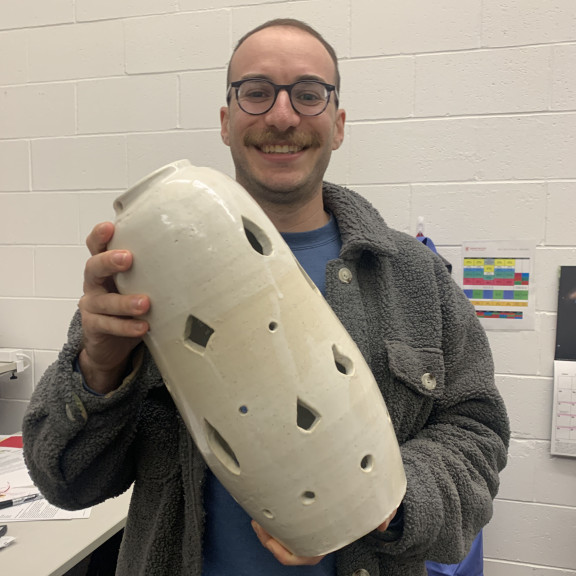50p

Under the Sea: Brentwood’s Artificial Reefs
Over the past couple of months, students of Life Sciences 11 have been collaborating with the pottery studio to create artificial reefs for marine life living in the ocean waters around Brentwood.
Artificial reefs are human-made structures that are designed to mimic the structure and function of natural reefs. They can be constructed from a variety of materials such as concrete, steel, and other durable materials. These reefs provide shelter, food, and other necessary elements for biodiversity and a productive ocean which, in turn, creates a rich diversity of marine life.
“Participating in this project has allowed me to combine my two passions of creating pottery and saving marine life together and I could not be more proud of the environmental impact I have made at my school” Ava T, Alex ‘24 shares.
The Mill Bay ocean floor is mostly sand and mud and there are not a lot of hard surfaces for organisms to attach to and live in. On the Brentwood docks, the wooden pillars act as a site for animals like oysters and muscles to attach to. The pilings on the docks act as a nice substrate for the animals, however, they are exposed and that acts as a survival hazard for the animals as they are more vulnerable to predators. So the main goal of this project is to create a permanent reef that is more horizontal and sprawling out so that marine life can have access to safer shelter.
There are currently three small artificial reefs at the bottom of the ocean made by Science 11 students with the help of ceramics instructor Mr Lyons. The environmentally-friendly pottery habitats are made out of glazed clay pots and will act as permanent structures that provide habitats for the animals. “Clay is an extremely versatile resource so I thoroughly enjoyed having the opportunity to collaborate with the Life Sciences class in creating the artificial reefs. It was a learning experience for all” commented Mr Lyons.
After a couple of years, when the organisms have utilized the pottery substrates in their habitats, future Life Sciences 11 students will have the opportunity to retrieve the structures and study what they can find! “The main organisms the students and I are hoping to see inhabit these reefs include starfish, nudibranchs (a type of sea slug), crabs, sea sponges, anemones, muscles, barnacles, coralline algae, and if we get lucky… an octopus!” Mr Hacker Teper, Life Sciences 11 teacher enthuses.
Thank you to Mr Hacker Teper and Mr Lyons and their students for taking initiative on such an environmentally impactful project that allows the Life Sciences 11 students an opportunity to participate in a hands-on, creative learning experience. Special shoutout also to the Brentwood scuba diving team for taking the underwater photos of the reefs.
Hopefully, this artificial reef initiative will continue to expand in future years and Mill Bay will be filled with an abundance of marine life.
Deborah Z, Alex ‘23
Artificial reefs are human-made structures that are designed to mimic the structure and function of natural reefs. They can be constructed from a variety of materials such as concrete, steel, and other durable materials. These reefs provide shelter, food, and other necessary elements for biodiversity and a productive ocean which, in turn, creates a rich diversity of marine life.
“Participating in this project has allowed me to combine my two passions of creating pottery and saving marine life together and I could not be more proud of the environmental impact I have made at my school” Ava T, Alex ‘24 shares.
The Mill Bay ocean floor is mostly sand and mud and there are not a lot of hard surfaces for organisms to attach to and live in. On the Brentwood docks, the wooden pillars act as a site for animals like oysters and muscles to attach to. The pilings on the docks act as a nice substrate for the animals, however, they are exposed and that acts as a survival hazard for the animals as they are more vulnerable to predators. So the main goal of this project is to create a permanent reef that is more horizontal and sprawling out so that marine life can have access to safer shelter.
There are currently three small artificial reefs at the bottom of the ocean made by Science 11 students with the help of ceramics instructor Mr Lyons. The environmentally-friendly pottery habitats are made out of glazed clay pots and will act as permanent structures that provide habitats for the animals. “Clay is an extremely versatile resource so I thoroughly enjoyed having the opportunity to collaborate with the Life Sciences class in creating the artificial reefs. It was a learning experience for all” commented Mr Lyons.
After a couple of years, when the organisms have utilized the pottery substrates in their habitats, future Life Sciences 11 students will have the opportunity to retrieve the structures and study what they can find! “The main organisms the students and I are hoping to see inhabit these reefs include starfish, nudibranchs (a type of sea slug), crabs, sea sponges, anemones, muscles, barnacles, coralline algae, and if we get lucky… an octopus!” Mr Hacker Teper, Life Sciences 11 teacher enthuses.
Thank you to Mr Hacker Teper and Mr Lyons and their students for taking initiative on such an environmentally impactful project that allows the Life Sciences 11 students an opportunity to participate in a hands-on, creative learning experience. Special shoutout also to the Brentwood scuba diving team for taking the underwater photos of the reefs.
Hopefully, this artificial reef initiative will continue to expand in future years and Mill Bay will be filled with an abundance of marine life.
Deborah Z, Alex ‘23